在关于利用maven搭建ssm的博客,我们一起来探讨下问的最多的问题中,我遗留了一个问题:Spring mvc是何时、何地、如何将Model中的属性绑定到哪个作用域,这里的作用域指的是Servlet的四大作用域;不了解问题背景的可以回过头去看看我的上篇博文。
明确的解答我会放到最后,在解答问题之前,我先和大家一起来捋一捋Spring mvc的工作原理。废话不多说,开始我们神秘的探险之旅!
应用示例
在讲工作原理之前,我们先看一个简单的spring mvc(ssm)示例,以及实现的效果
工程代码地址:ssm-web
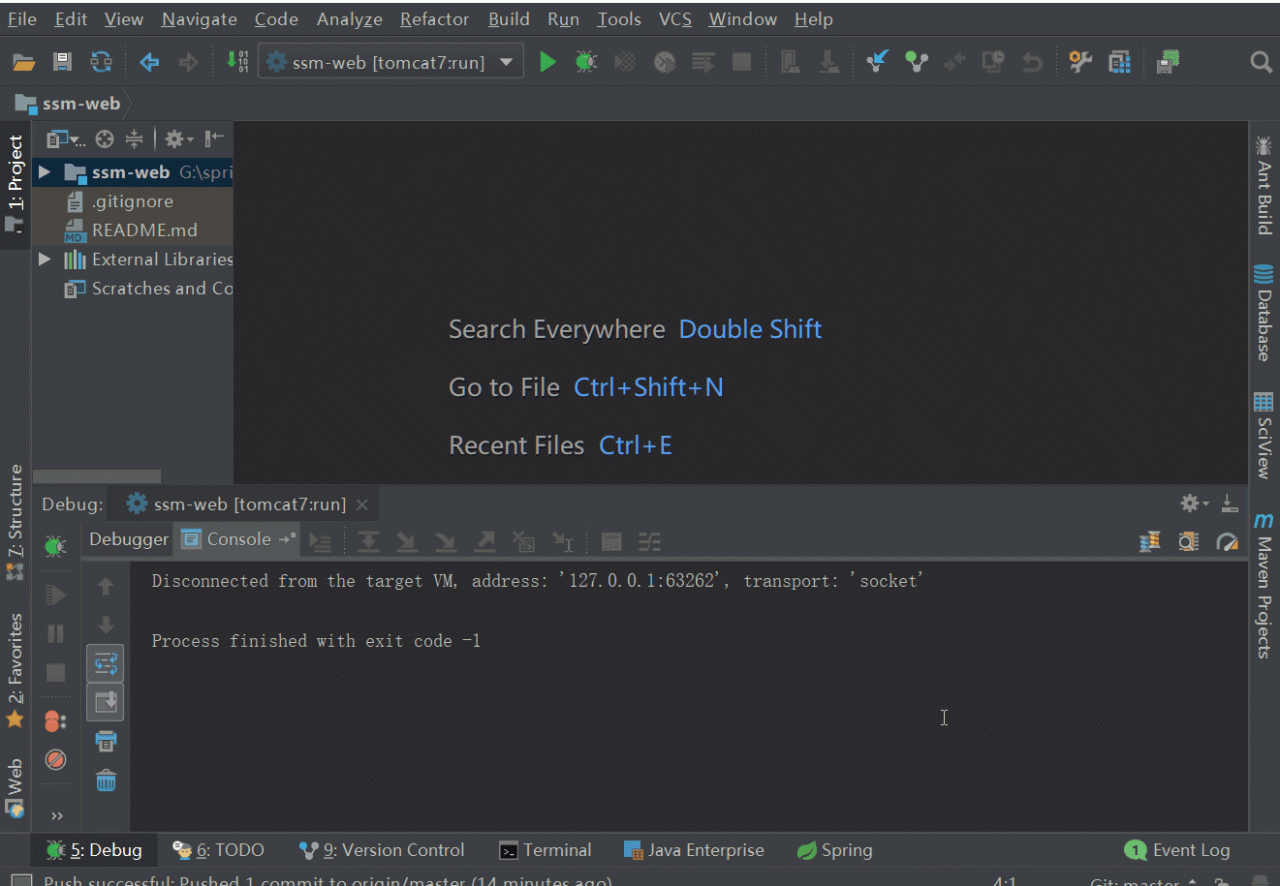
工程结构与效果如上所示,我们不做过多的探究,我们打起精神往下看本篇的重点
工作原理
准备 – 资源的加载与初始化
1、DispatcherServlet 静态初始化
DispatcherServlet中有如下静态块
static {
// Load default strategy implementations from properties file.
// This is currently strictly internal and not meant to be customized
// by application developers.
try {
ClassPathResource resource = new ClassPathResource(DEFAULT_STRATEGIES_PATH, DispatcherServlet.class);
defaultStrategies = PropertiesLoaderUtils.loadProperties(resource);
}
catch (IOException ex) {
throw new IllegalStateException(“Could not load DispatcherServlet.properties: ” ex.getMessage());
}
}
这里会将DispatcherServlet.properties中的内容读取到DispatcherServlet的属性:private static final Properties defaultStrategies中,DispatcherServlet.properties内容如下
Default implementation classes for DispatcherServlets strategy interfaces.
Used as fallback when no matching beans are found in the DispatcherServlet context.
Not meant to be customized by application developers.
org.springframework.web.servlet.LocaleResolver=org.springframework.web.servlet.i18n.AcceptHeaderLocaleResolver
org.springframework.web.servlet.ThemeResolver=org.springframework.web.servlet.theme.FixedThemeResolver
org.springframework.web.servlet.HandlerMapping=org.springframework.web.servlet.handler.BeanNameUrlHandlerMapping,\
org.springframework.web.servlet.mvc.annotation.DefaultAnnotationHandlerMapping
org.springframework.web.servlet.HandlerAdapter=org.springframework.web.servlet.mvc.HttpRequestHandlerAdapter,\
org.springframework.web.servlet.mvc.SimpleControllerHandlerAdapter,\
org.springframework.web.servlet.mvc.annotation.AnnotationMethodHandlerAdapter
org.springframework.web.servlet.HandlerExceptionResolver=org.springframework.web.servlet.mvc.annotation.AnnotationMethodHandlerExceptionResolver,\
org.springframework.web.servlet.mvc.annotation.ResponseStatusExceptionResolver,\
org.springframework.web.servlet.mvc.support.DefaultHandlerExceptionResolver
org.springframework.web.servlet.RequestToViewNameTranslator=org.springframework.web.servlet.view.DefaultRequestToViewNameTranslator
org.springframework.web.servlet.ViewResolver=org.springframework.web.servlet.view.InternalResourceViewResolver
org.springframework.web.servlet.FlashMapManager=org.springframework.web.servlet.support.SessionFlashMapManager
指定了DispatcherServlet策略接口的默认实现,后续DispatcherServlet初始化策略的时候会用到
2、interceptor定义的加载
spring启动过程中会调用InterceptorsBeanDefinitionParser的parse方法来解析出我们自定义的interceptor定义,封装成MappedInterceptor类型的bean定义,并放到spring容器中;我们可以简单的认为spring容器中已经存在了我们自定义的interceptor的bean定义
3、DispatcherServlet初始化策略:initStrategies
DispatcherServlet的继承图如下
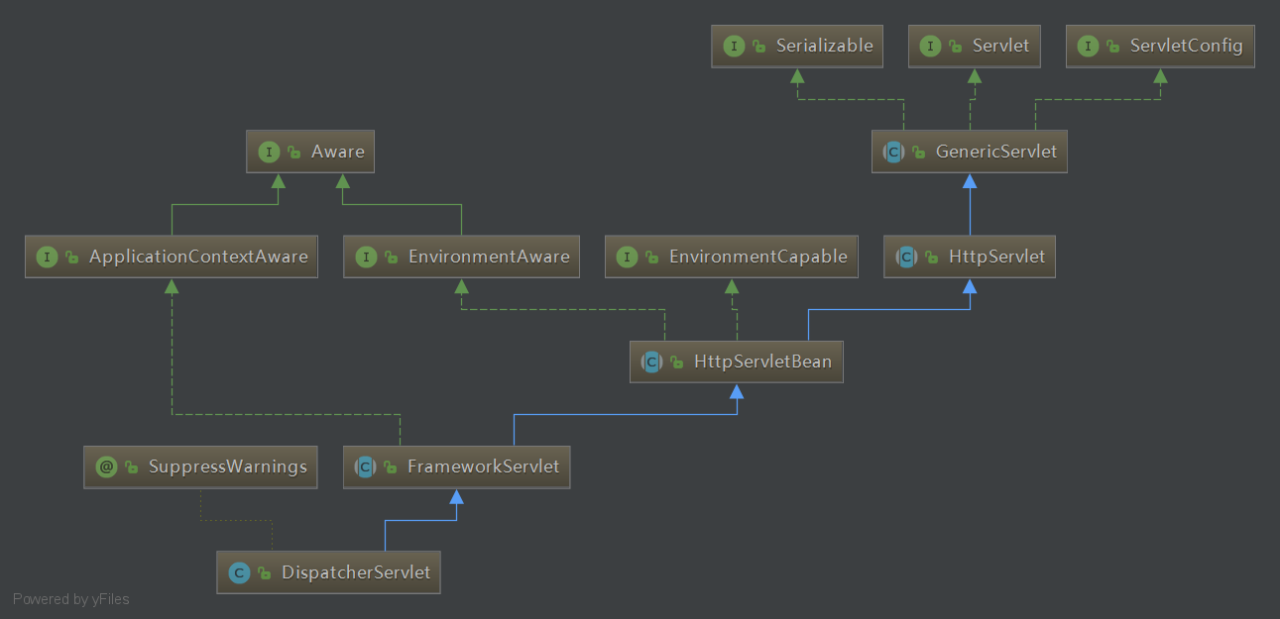
DispatcherServlet是一个Servlet,tomcat启动过程中会调用其init方法,一串的调用后,会调用DispatcherServlet的initStrategies方法
protected void initStrategies(ApplicationContext context) {
initMultipartResolver(context);
initLocaleResolver(context);
initThemeResolver(context);
initHandlerMappings(context);
initHandlerAdapters(context);
initHandlerExceptionResolvers(context);
initRequestToViewNameTranslator(context);
initViewResolvers(context);
initFlashMapManager(context);
}
实例化步骤1中的默认实现,并填充到DispatcherServlet各个属性值中
4、DefaultAnnotationHandlerMapping的拦截器初始化
DispatcherServlet.properties种指定了两个默认的HandlerMapping:BeanNameUrlHandlerMapping、DefaultAnnotationHandlerMapping,这两者的类继承图如下(我们暂时只关注DefaultAnnotationHandlerMapping)
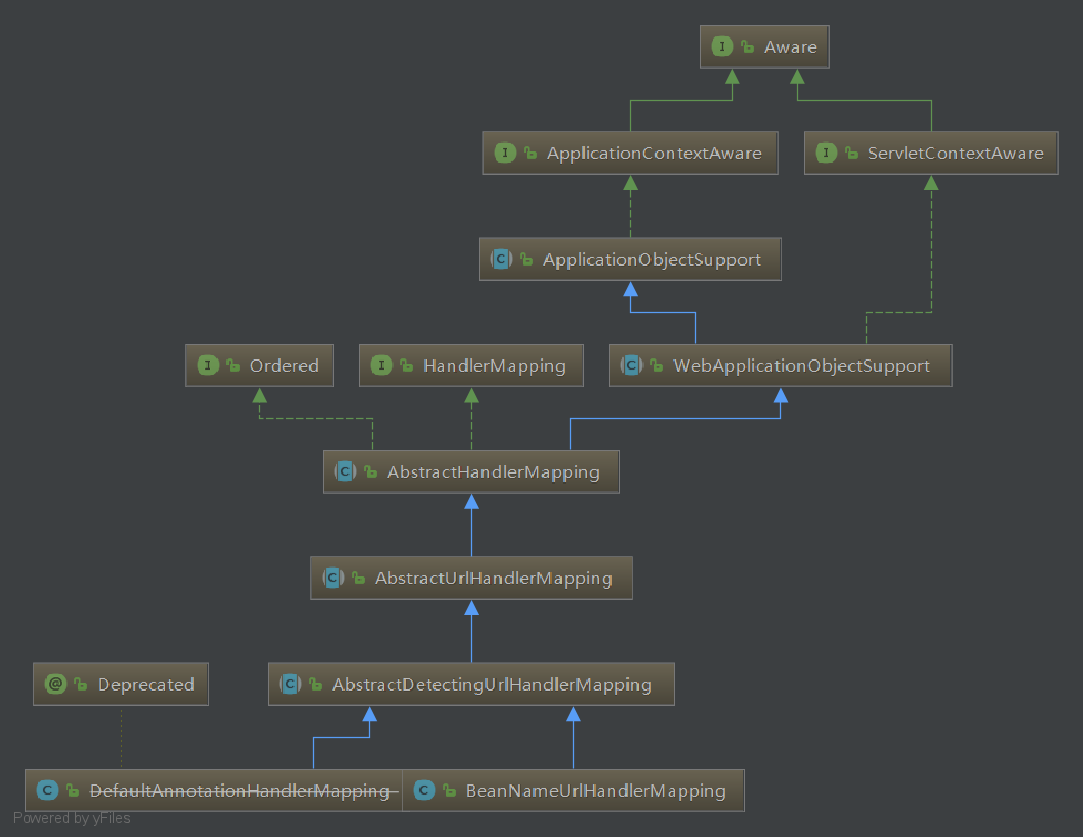
DefaultAnnotationHandlerMapping间接实现了ApplicationContextAware,那么在DefaultAnnotationHandlerMapping实例初始化过程中,会调用setApplicationContext(ApplicationContext applicationContext)方法,一串调用后,会来到AbstractUrlHandlerMapping的initApplicationContext()
@Override
protected void initApplicationContext() throws BeansException {
extendInterceptors(this.interceptors);
detectMappedInterceptors(this.mappedInterceptors);
initInterceptors();
}
初始化了DefaultAnnotationHandlerMapping的拦截器:interceptor
我们来看下具体的初始化过程,看看上面的顺序是否只是我个人的臆想?
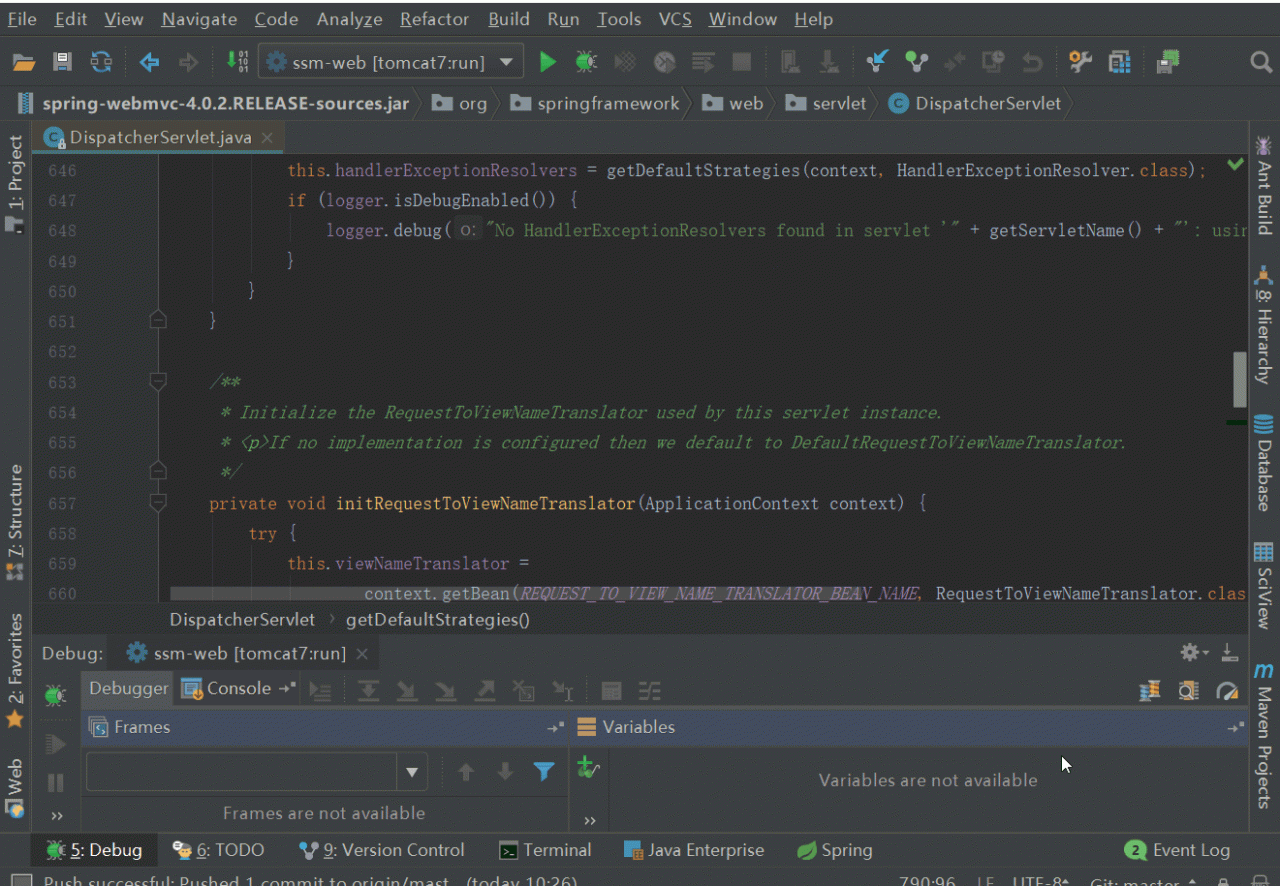
可以看到,初始化顺序就是我们上面说的,不是我个人的意淫;此时的DefaultAnnotationHandlerMapping中有我们自定义的MyInterceptor。初始化过程我们需要关注的就是上述这些,下面我们一起看看具体请求的过程
请求的处理
请求从servlet的service开始,一路到DispatcherServlet的doDispatch,如下图
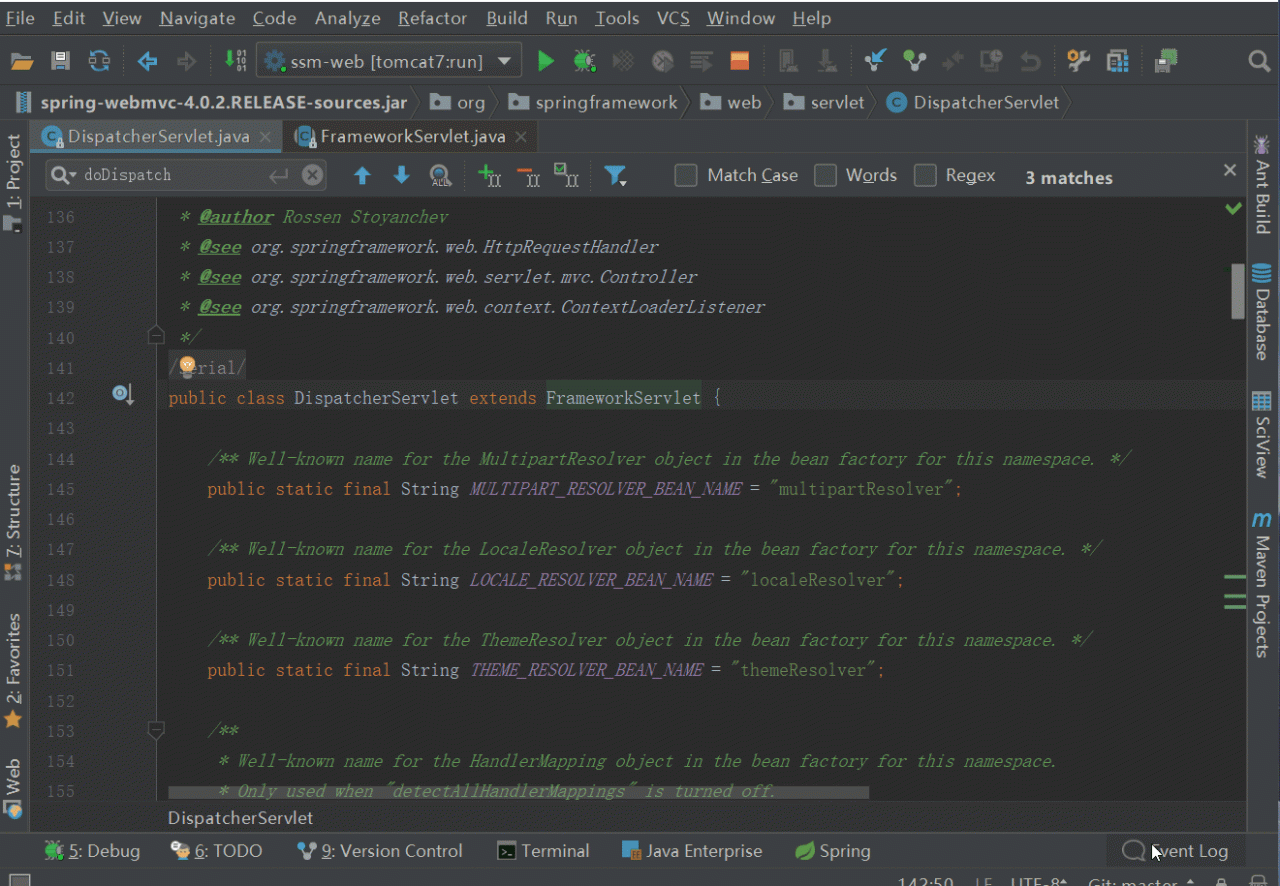
/**
* Process the actual dispatching to the handler. 将请求分发到具体的handler,也就是我们的controller
*
The handler will be obtained by applying the servlets HandlerMappings in order.
* The HandlerAdapter will be obtained by querying the servlets installed HandlerAdapters
* to find the first that supports the handler class.
*
All HTTP methods are handled by this method. Its up to HandlerAdapters or handlers
* themselves to decide which methods are acceptable.
* @param request current HTTP request
* @param response current HTTP response
* @throws Exception in case of any kind of processing failure
*/
protected void doDispatch(HttpServletRequest request, HttpServletResponse response) throws Exception {
HttpServletRequest processedRequest = request;
HandlerExecutionChain mappedHandler = null;
boolean multipartRequestParsed = false;
WebAsyncManager asyncManager = WebAsyncUtils.getAsyncManager(request);
try {
ModelAndView mv = null;
Exception dispatchException = null;
try {
processedRequest = checkMultipart(request);
multipartRequestParsed = processedRequest != request;
// Determine handler for the current request. 决定哪个handler来处理当前的请求
// mappedHandler是由handler和interceptor集合组成的一个执行链,有点类似FilterChain
mappedHandler = getHandler(processedRequest);
if (mappedHandler == null || mappedHandler.getHandler() == null) {
noHandlerFound(processedRequest, response);
return;
}
// Determine handler adapter for the current request. 决定哪个adapter来处理当前的请求
// handlerMapping是找出适配的handler,而真正回调handler的是adapter
HandlerAdapter ha = getHandlerAdapter(mappedHandler.getHandler());
// Process last-modified header, if supported by the handler.
String method = request.getMethod();
boolean isGet = “GET”.equals(method);
if (isGet || “HEAD”.equals(method)) {
long lastModified = ha.getLastModified(request, mappedHandler.getHandler());
if (logger.isDebugEnabled()) {
String requestUri = urlPathHelper.getRequestUri(request);
logger.debug(“Last-Modified value for [” requestUri “] is: ” lastModified);
}
if (new ServletWebRequest(request, response).checkNotModified(lastModified)
2.分享目的仅供大家学习和交流,您必须在下载后24小时内删除!
3.不得使用于非法商业用途,不得违反国家法律。否则后果自负!
4.本站提供的源码、模板、插件等其他资源,都不包含技术服务请大家谅解!
5.如有链接无法下载或失效,请联系管理员处理!
6.本站资源售价只是赞助,收取费用仅维持本站的日常运营所需!
